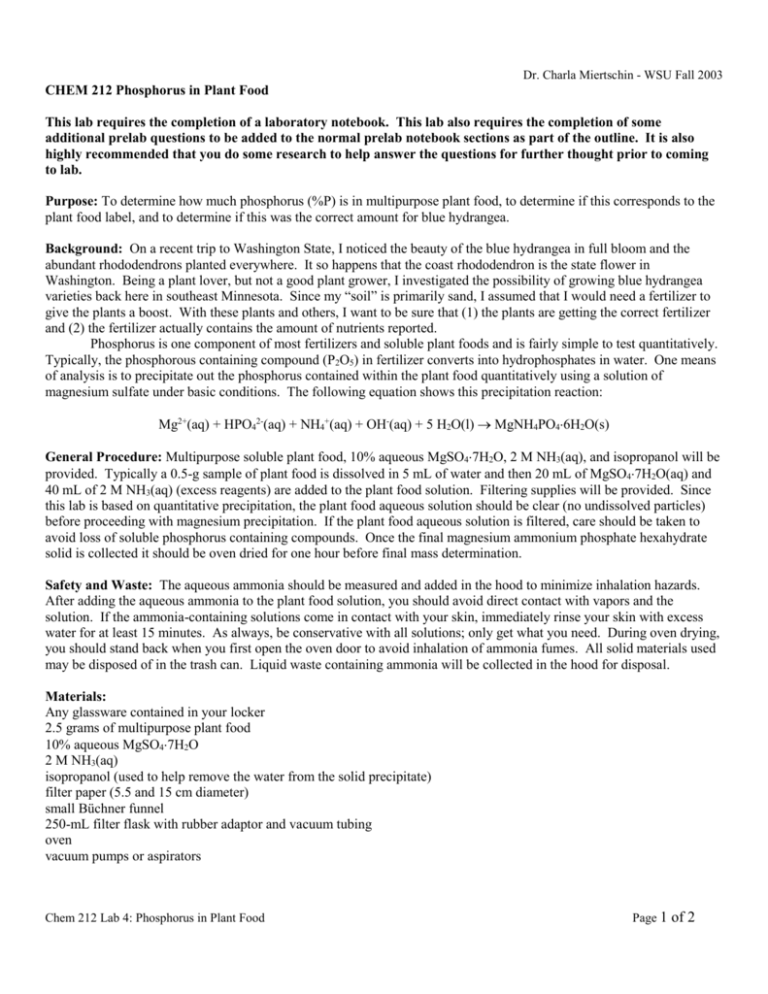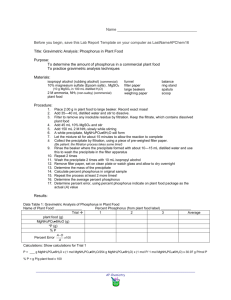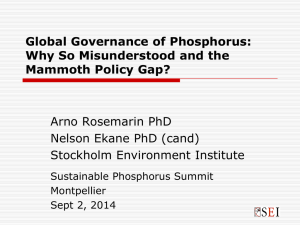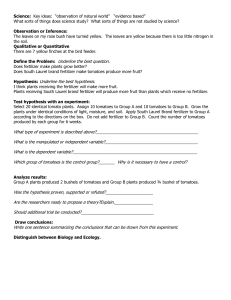Chem 212 Lab 5: Phosphorus in Plant Food
advertisement

Dr. Charla Miertschin - WSU Fall 2003 CHEM 212 Phosphorus in Plant Food This lab requires the completion of a laboratory notebook. This lab also requires the completion of some additional prelab questions to be added to the normal prelab notebook sections as part of the outline. It is also highly recommended that you do some research to help answer the questions for further thought prior to coming to lab. Purpose: To determine how much phosphorus (%P) is in multipurpose plant food, to determine if this corresponds to the plant food label, and to determine if this was the correct amount for blue hydrangea. Background: On a recent trip to Washington State, I noticed the beauty of the blue hydrangea in full bloom and the abundant rhododendrons planted everywhere. It so happens that the coast rhododendron is the state flower in Washington. Being a plant lover, but not a good plant grower, I investigated the possibility of growing blue hydrangea varieties back here in southeast Minnesota. Since my “soil” is primarily sand, I assumed that I would need a fertilizer to give the plants a boost. With these plants and others, I want to be sure that (1) the plants are getting the correct fertilizer and (2) the fertilizer actually contains the amount of nutrients reported. Phosphorus is one component of most fertilizers and soluble plant foods and is fairly simple to test quantitatively. Typically, the phosphorous containing compound (P2O5) in fertilizer converts into hydrophosphates in water. One means of analysis is to precipitate out the phosphorus contained within the plant food quantitatively using a solution of magnesium sulfate under basic conditions. The following equation shows this precipitation reaction: Mg2+(aq) + HPO42-(aq) + NH4+(aq) + OH-(aq) + 5 H2O(l) MgNH4PO46H2O(s) General Procedure: Multipurpose soluble plant food, 10% aqueous MgSO47H2O, 2 M NH3(aq), and isopropanol will be provided. Typically a 0.5-g sample of plant food is dissolved in 5 mL of water and then 20 mL of MgSO47H2O(aq) and 40 mL of 2 M NH3(aq) (excess reagents) are added to the plant food solution. Filtering supplies will be provided. Since this lab is based on quantitative precipitation, the plant food aqueous solution should be clear (no undissolved particles) before proceeding with magnesium precipitation. If the plant food aqueous solution is filtered, care should be taken to avoid loss of soluble phosphorus containing compounds. Once the final magnesium ammonium phosphate hexahydrate solid is collected it should be oven dried for one hour before final mass determination. Safety and Waste: The aqueous ammonia should be measured and added in the hood to minimize inhalation hazards. After adding the aqueous ammonia to the plant food solution, you should avoid direct contact with vapors and the solution. If the ammonia-containing solutions come in contact with your skin, immediately rinse your skin with excess water for at least 15 minutes. As always, be conservative with all solutions; only get what you need. During oven drying, you should stand back when you first open the oven door to avoid inhalation of ammonia fumes. All solid materials used may be disposed of in the trash can. Liquid waste containing ammonia will be collected in the hood for disposal. Materials: Any glassware contained in your locker 2.5 grams of multipurpose plant food 10% aqueous MgSO47H2O 2 M NH3(aq) isopropanol (used to help remove the water from the solid precipitate) filter paper (5.5 and 15 cm diameter) small Büchner funnel 250-mL filter flask with rubber adaptor and vacuum tubing oven vacuum pumps or aspirators Chem 212 Lab 4: Phosphorus in Plant Food Page 1 of 2 Additional Questions to Answered as Part of Your Prelab in the outline section: 1. Calculate the %P in P2O5. 2. If the precipitation reaction above was carried out on a 5.00-g sample of plant food and 3.00 g of MgNH4PO46H2O(s) was isolated, what is the %P in the plant food? Questions For Further Thought (To be addressed in paragraph form somewhere within your conclusion section) Make sure to cite any references that you may have had to use. 1. What do the “numbers” (usually a set of three) on fertilizer mean? What were the numbers on the fertilizer that you tested? 2. On the fertilizer bottle, specifically how is the phosphorus reported on the label? 3. Based on your findings, do you think that the percentage that is reported on the bottle corresponds to %P or to %P2O5? 4. Is the plant food tested appropriate for blue hydrangea? What other factors should I consider for growing blue hydrangea? Note: Always note the source(s) of information obtained.











